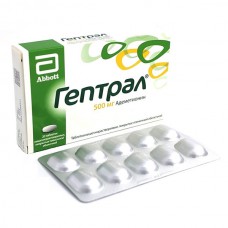Expiration date: 06/2025
Composition
Each tablet contains:
Active substance: ademethionine 1,4-butandisulfonate 949.0 mg (corresponds to 500 mg of the ademethionine ion).
Excipients: silicon dioxide colloidal - 5.50 mg, microcrystalline cellulose - 118.00 mg, sodium carboxymethyl starch (type A) - 22.00 mg, magnesium stearate - 5.50 mg, tablet shell: methacrylic acid and ethylacrylate copolymer (1:1) - 32.63 mg, macrogol-6000 - 9.56 mg, polysorbate-80 - 0.52 mg, simethicon emulsion (30%) - 0.40 mg, sodium hydroxide - 0.44 mg, talc - 21.77 mg.
Dosage form
tablets coated with an intestinal-soluble coating
Description
The tablets are oval in shape, biconvex, smooth, white to light yellow in color, covered with a film shell.
Pharmacodynamics
Ademethionine belongs to the group of hepatoprotectors, it also has antidepressant activity. It has choleretic and cholekinetic effects, has detoxifying, regenerating, antioxidant, antifibrosing and neuroprotective properties.
It replenishes the deficiency of S-adenosyl-L-methionine (ademethionine) and stimulates its production in the body, it is contained in all body environments. The highest concentration of ademethionine was noted in the liver and brain. Performs a key role in the metabolic processes of the body, takes part in important biochemical reactions: transmethylation, transulfurization, transamination. In transmethylation reactions, ademethionine donates a methyl group for the synthesis of cell membrane phospholipids, neurotransmitters, nucleic acids, proteins, hormones, etc. In transulfurization reactions, ademethionine is a precursor of cysteine, taurine, glutathione (providing the redox mechanism of cellular detoxification), coenzyme A (it is included in the biochemical reactions of the tricarboxylic acid cycle and replenishes the energy potential of the cell). Increases the content of glutamine in the liver, cysteine and taurine in plasma, reduces the content of methionine in serum, normalizing metabolic reactions in the liver. After decarboxylation, it participates in aminopropylation reactions as a precursor of polyamines putrescine (a stimulator of cell regeneration and proliferation of hepatocytes), spermidine and spermine, which are part of the ribosome structure, which reduces the risk of fibrosis. It has a choleretic effect. Ademethionine normalizes the synthesis of endogenous phosphatidylcholine in hepatocytes, which increases the fluidity and polarization of membranes. This improves the function of bile acid transport systems associated with hepatocyte membranes and promotes the passage of bile acids into the biliary tract. It is effective in the intra-lobular variant of cholestasis (violation of the synthesis and flow of bile). Ademethionine reduces the toxicity of bile acids in the hepatocyte by conjugating and sulfating them. Conjugation with taurine increases the solubility of bile acids and their excretion from the hepatocyte. The process of sulfating bile acids contributes to the possibility of their elimination by the kidneys, facilitates passage through the hepatocyte membrane and excretion with bile. In addition, the sulfated bile acids themselves additionally protect the membranes of liver cells from the toxic effects of unsulfated bile acids (in high concentrations present in hepatocytes with intrahepatic cholestasis). In patients with diffuse liver diseases (cirrhosis, hepatitis) with intrahepatic cholestasis syndrome, ademethionine reduces the severity of itching and changes in biochemical parameters, including the concentration of direct bilirubin, the activity of alkaline phosphatase, aminotransferases, etc. The choleretic and hepatoprotective effect persists up to 3 months after discontinuation of treatment. It has been shown to be effective in hepatopathies caused by various hepatotoxic drugs. Prescribing to patients with opioid addiction accompanied by liver damage leads to regression of clinical manifestations of abstinence, improvement of the functional state of the liver and microsomal oxidation processes. Antidepressant activity manifests itself gradually, starting from the end of the first week of treatment, and stabilizes within 2 weeks of treatment. It is effective in recurrent endogenous and neurotic depression resistant to amitriptyline. It has the ability to interrupt relapses of depression. Ademethionine increases the synthesis of proteoglycans and leads to partial regeneration of cartilage tissue.
Pharmacokinetics
Suction
The maximum concentrations (Cmax) of ademethionine in plasma are dose-dependent and amount to 0.5-1 mg / l 3-5 hours after a single oral administration in doses from 400 to 1000 mg. Bioavailability increases when taken on an empty stomach. The cmax of ademethionine in plasma decreases to the initial level within 24 hours.
Distribution
When using ademethionine at a dose of 500 mg, the volume of distribution (Vd) is 0.44 l/kg. The degree of binding to plasma proteins is insignificant and amounts to 5%.
Metabolism
The process of formation, expenditure and re-formation of ademethionine is called the ademethionine cycle. At the first stage of this cycle, ademethionine-dependent methylases use ademethionine as a substrate for the production of S-adenosylhomocysteine, which is then hydrolyzed to homocysteine and adenosine by S-adenosylhomocysteine hydralase. Homocysteine, in turn, undergoes reverse transformation to methionine by transferring the methyl group from 5-methyltetrahydrofolate. As a result, methionine can be converted by type I methionine-adenosyl transferase into ademethionine, completing the cycle.
Withdrawal
In studies in healthy volunteers, when ingested labeled (methyl 14C) S-adenosyl-L-methionine, 15.5 1.5% radioactivity was detected in urine after 48 hours, and 23.5 3.5% radioactivity in feces after 72 hours. Thus, about 60% was deposited.
Indications for use
- Intrahepatic cholestasis in precyrrotic and cirrhotic conditions, which can be observed in the following diseases:
- fatty liver dystrophy,
- chronic hepatitis,
- toxic liver lesions of various etiologies, including alcoholic, viral, medicinal (antibiotics, antitumor, anti-tuberculosis and antiviral drugs, tricyclic antidepressants, oral contraceptives),
- chronic stone-free cholecystitis,
- cholangitis,
- cirrhosis of the liver,
- encephalopathy, including those associated with liver failure (alcoholic, etc.).
- Intrahepatic cholestasis in pregnant women.
- Symptoms of depression.
Contraindications
Genetic disorders affecting the methionine cycle, and/or causing homocystinuria and/or hyperhomocysteinemia (for example, cystathionine beta-synthase deficiency, cyanocobal amine metabolism disorder).
Hypersensitivity to any of the components of the drug.
Age up to 18 years (experience of medical use in children is limited).
Use during pregnancy and lactation
In clinical studies, it was shown that the use of ademethionine in the third trimester of pregnancy did not cause any undesirable effects. The use of Heptral in pregnant women in the first and second trimesters, as well as during breastfeeding, is possible only if the potential benefit to the mother exceeds the possible risk to the fetus or child.
Interaction
There is a report of an excess serotonin syndrome in a patient who took ademethionine and clomipramine. It is believed that such an interaction is possible, and ademethionine should be used with caution together with selective serotonin reuptake inhibitors, tricyclic antidepressants (such as clomipramine), as well as herbs and drugs containing tryptophan.
Method of administration and dosage
Inside. Tablets should be taken whole, without chewing, between meals.
Tablets of the drug Heptral should be removed from the blister immediately before ingestion. If the tablets have a color other than white to light yellow (due to leakage of aluminum foil), the drug Heptral is not recommended.
Initial therapy:
The recommended dose is 10-25 mg / kg / day orally.
Depression
The usual initial dose is 500-800 mg / day, the total daily dose should not exceed 1600 mg.
Intrahepatic cholestasis
The usual initial dose is 500-800 mg / day, the total daily dose should not exceed 1600 mg.
Supportive therapy:
500 or 800-1600 mg/day.
Therapy with Heptral can be started with intravenous or intramuscular administration followed by the use of Heptral in the form of tablets or immediately with the use of Heptral in the form of tablets. Elderly patients
Clinical experience with the use of the drug Heptral has not revealed any differences in its effectiveness in elderly patients and younger patients. However, given the high probability of existing liver, kidney or heart function disorders, other concomitant pathology or simultaneous therapy with other drugs, the dose of Heptral should be selected with caution in elderly patients, starting the use of the drug from the lower limit of the dose range.
Kidney failure
There are limited clinical data on the use of the drug Heptral in patients with renal insufficiency, in this regard, caution is recommended when using the drug Heptral in such patients.
Liver failure
The parameters of the pharmacokinetics of ademetionine are similar in healthy volunteers and in patients with chronic liver diseases.
Children
The use of the drug Heptral in children is contraindicated (efficacy and safety have not been established).
Overdose
Overdose with Heptral is unlikely. In case of overdose, it is recommended to monitor the patient and conduct symptomatic therapy.
Special instructions
Given the tonic effect of the drug, it is not recommended to take it before bedtime. When using the drug Heptral in patients with cirrhosis of the liver against the background of hyperazotemia, systematic monitoring of the nitrogen content in the blood is necessary. During long-term therapy, it is necessary to determine the content of urea and creatinine in the blood serum.
It is not recommended to use ademethionine in patients with bipolar disorders. There are reports of the transition of depression to hypomania or mania in patients taking ademethionine.
Patients with depression have an increased risk of suicide and other serious adverse events, therefore, during treatment with ademethionine, such patients should be under constant medical supervision to assess and treat symptoms of depression. Patients should inform the doctor if their symptoms of depression do not decrease or worsen with ademethionine therapy.
There are also reports of a sudden appearance or increase in anxiety in patients taking ademethionine. In most cases, discontinuation of therapy was not required, in several cases, anxiety disappeared after dose reduction or drug withdrawal.
Since cyanocobalamin and folic acid deficiency can reduce the content of ademethionine in patients at risk (with anemia, liver disease, pregnancy or the likelihood of vitamin deficiency, due to other diseases or diet, for example, vegetarians), the content of vitamins in blood plasma should be monitored. If insufficiency is detected, it is recommended to take cyanocobalamin and folic acid before starting treatment with ademethionine or simultaneous administration with ademethionine.
Taking ademethionine may affect the result of the determination of homocysteine in blood plasma obtained by immunological methods.
For patients taking ademethionine, it is recommended to use non-immunological methods of analysis to determine the content of homocysteine.
Influence on the ability to drive vehicles and manage mechanisms
In some patients, dizziness may occur when taking the drug Heptral. It is not recommended to drive vehicles and work with mechanisms while taking the drug Heptral until patients are sure that therapy does not affect the ability to engage in this type of activity.
Release form
Tablets coated with an intestinal-soluble shell, 500 mg.
Packaging
10 tablets in a blister of PA /PVC/ AL and aluminum foil. 1 or 2 blisters together with the instructions for use are placed in a cardboard pack.
Conditions of release from pharmacies
By prescription
Storage conditions
At a temperature not higher than 25 C.
Keep out of reach of children!
Expiration date
3 years. The drug should not be used after the expiration date.


